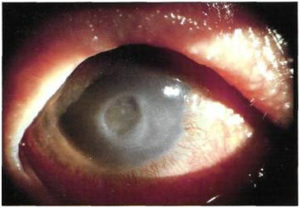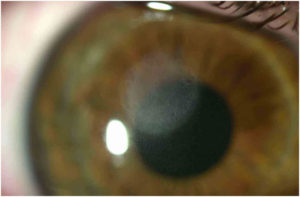What are corneal ulcers?
Corneal ulcers are open sores on the cornea — the clear front window of the eye. The cornea covers the iris (the colored portion of the eye) and the round pupil, much like a watch crystal covers the face of a watch.
Symptoms of corneal ulcers:
Redness of the eye
Severe pain and soreness of the eye
The feeling of having something in your eye
Pus or other discharge
Blurred vision
Sensitivity to light
Swelling of the eyelids, or a a white spot on your cornea that you may or may not be able to see when looking in the mirror
If you think you have a corneal ulcer or have any eye symptoms that concern you, it is important to contact Phoenix Ophthalmologists to schedule an appointment immediately. If not treated, corneal ulcers can severely and permanently damage your vision and even cause blindness.
Who is at risk for corneal ulcers?
People at risk for corneal ulcers include those who:
Wear contact lenses
Have cold sores, chicken pox or shingles
Use steroid eye drops
Have dry eye
Have eyelid disorders that prevent proper function of the eyelid
Suffer from tears or burns to the cornea
What causes corneal ulcers?
Corneal ulcers are usually caused by three types of infections:
BACTERIAL INFECTIONS. These are common in contact lens wearers, especially in people using extended-wear lenses.
VIRAL INFECTIONS. The virus that causes cold sores (the herpes simplex virus) and the virus that causes chicken pox and shingles (the varicella virus) can cause corneal ulcers.
FUNGAL INFECTIONS. Improper use of contact lenses or steroid eyedrops can lead to fungal infections, which in turn can cause corneal ulcers.
PARASITIC INFECTIONS (Acanthamoeba). Acanthamoeba are microscopic, single-celled amoeba that can cause human infection. They are the most common amoebae in fresh water and soil. When Acanthamoeba enters the eye it can cause severe infection, particularly for contact lens users.
Other causes of corneal ulcers include:
Tears or burns to the cornea caused by injury to the eye. Scratches, scrapes and cuts from fingernails, paper cuts, makeup brushes and tree branches can become infected by bacteria and lead to corneal ulcers.
Burns caused by caustic chemicals found in the workplace and at home can also cause corneal ulcers.
Dry eye syndrome.
Bell’s palsy and other eyelid disorders that prevent proper eyelid function. If the eyelid does not function properly, the cornea can dry out.
Many causes of corneal ulcers can be prevented. Use proper protective eyewear when doing any work or play that can lead to eye injury. And if you wear contact lenses, it is important to care for your contact lenses safely and correctly.
How are corneal ulcers diagnosed?
Dr. Van Buren uses a special dye called fluorescein (pronounced FLOR-uh-seen) to illuminate any damage to your cornea then examine your cornea using a special microscope called a slit lamp. The slit-lamp exam will allows our doctors to see the damage to your cornea and determine if you have a corneal ulcer. If Dr. Van Buren suspects that an infection is responsible for your corneal ulcer, a sample will be taken so that the infection can be identified and properly treated.
How are corneal ulcers treated?
Though usually treated on an outpatient basis, you may need to go to the hospital for treatment if an ulcer is severe enough.
Medical treatment
Antibiotics, antifungal or antiviral eyedrops are the mainstay of treatment. Sometimes antifungal tablets will be prescribed, or an injection of medication is given near the eye for treatment. Once any infection has diminished or is gone, then steroid or anti-inflammatory eyedrops may be used to reduce swelling and help prevent scarring. The use of steroid eyedrops is controversial and should only be used under close supervision by Phoenix Ophthalmologists. It is possible that steroid eyedrops may worsen an infection. Oral pain medication may be prescribed to reduce pain.
Surgical treatment
If corneal ulcers cannot be treated with medication, surgery may be needed to preserve your vision. A corneal transplant can replace your damaged cornea with a healthy donor cornea to restore vision.


